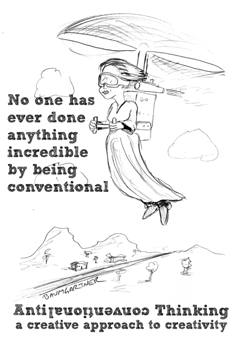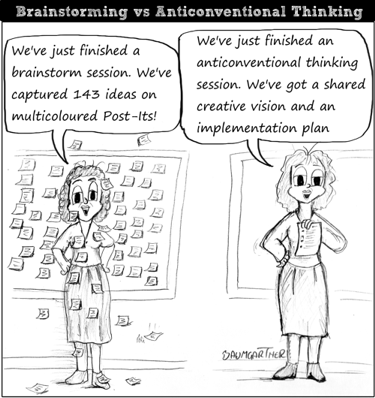
Anticonventional Thinking (ACT)
"The future of creative idea generation" - TEDxULB
See my TEDx video on ACT below
Anticonventional thinking (ACT) is a new, fun and effective approach to goal-oriented creative thinking. It is a method you can learn and use when you need to develop original ideas and make them happen.
ACT is based on scientific research into how the brain works as well as how groups collaborate and is modelled after the way artists, writers, composers and other highly creative people have thought and collaborated for centuries. As such, it is not so much a new process. Rather, it adopts the fluid thinking approach of highly creative people and turns it into an easy-to-follow structured method.

Better than Brainstorming
If you have tried brainstorming, only to be disappointed by the results, you will love ACT.
Here are three reasons why ACT is better:
-
Brainstorming aims to generate a long list of mostly mediocre ideas. ACT aims to build a single, sophisticated creative vision and an action plan.
-
Brainstorming prohibits criticism of ideas and welcomes conventional ideas. ACT prohibits conventional ideas and welcomes criticism of ideas. It is the only way to truly understand complex ideas and build upon them.
-
Brainstorming is an analytical approach based on outdated assumptions. ACT is a playful approached based on research.
Which do you think is likely to be a more effective approach to developing big creative ideas that are likely to be implemented and become innovations? Which would you prefer your colleagues use in your innovation programme?
ACT is a four step approach.
-
Play with the situation. You want to do something creative in a particular situation. Instead of trying to come up with ideas, play with the situation in your mind. Visualise it, explore it and let it ferment. Meditate on it. If you are working with a group, ask analytical, emotional and anticonventional questions. These actions help you understand the situation more deeply and enable your mind to build connections between the situation and all kinds of other things. These connections will enable you to build truly creative ideas.
-
Sexy Goals. If you are working with a group, formulate a sexy goal. A sexy goal is one that is provocative, exciting and interesting. A sexy goal makes the group understand the situation in new ways and makes it easier to come up with unconventional ideas. (If you are uncomfortable with a "sexy goal", we can use the term "extreme goal").
-
Build a creative vision. Play with ideas. Consider each idea. If it is boring, reject it (we do not want conventional ideas, remember?) If it is not boring, visualise applying it to the situation. How does it work? If it has potential, play with it and build it up. If it does not have potential, reject it and play with a new idea. Keep at it until a vision begins to form. Then develop the situation and continually try to make it less conventional.
-
Build an action plan. Deconstruct the vision into a series of steps that start from where you are now and end at the successful implementation of your creative vision. Assign someone to take charge of each step and then start on the first step.
You can learn more about ACT from the reading below. If you are interested in having me facilitate an ACT session with your team, lead an ACT workshop or speak about ACT at your upcoming event, get in touch -- or click here to learn more about my services. If you have a question or comment, share it with me!
Further Reading
My
TEDx talk on anticonventional thinking (ACT)
-- Jeffrey Baumgartner




